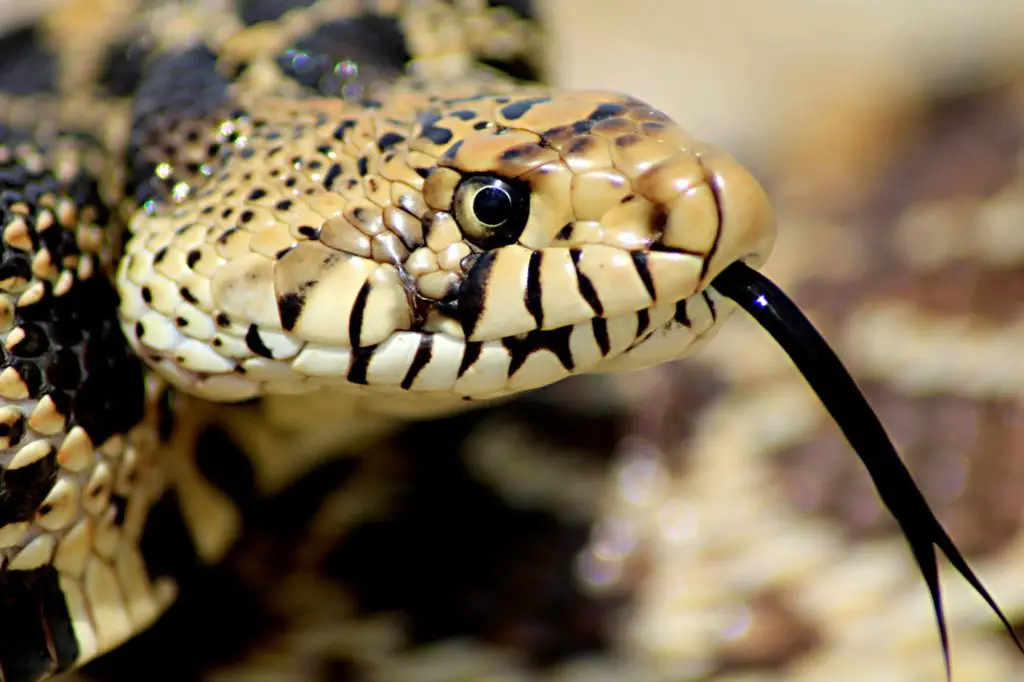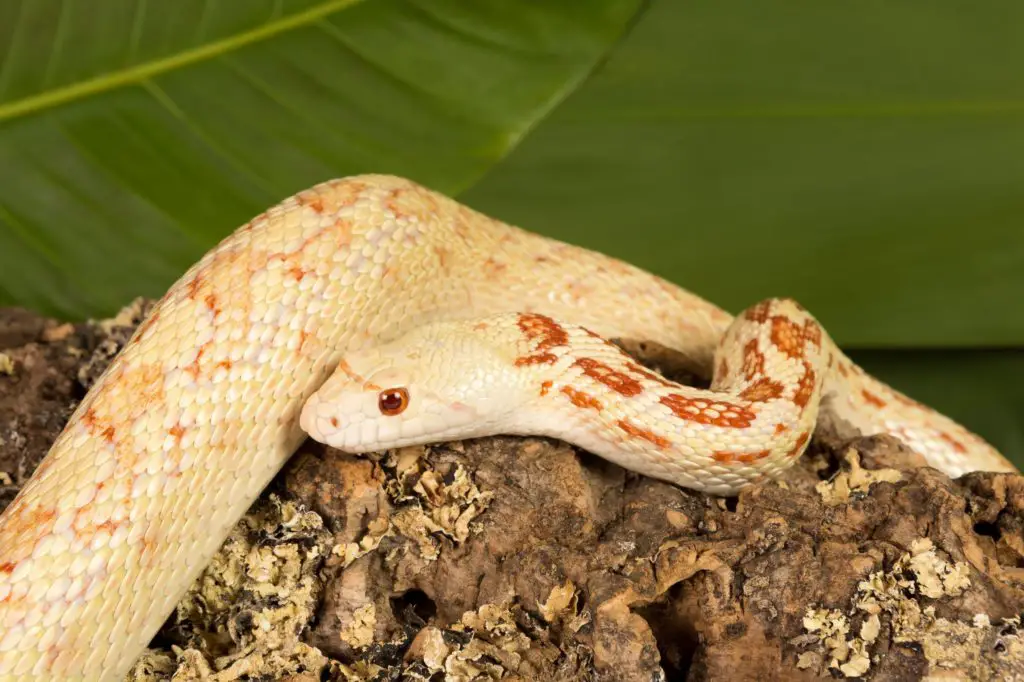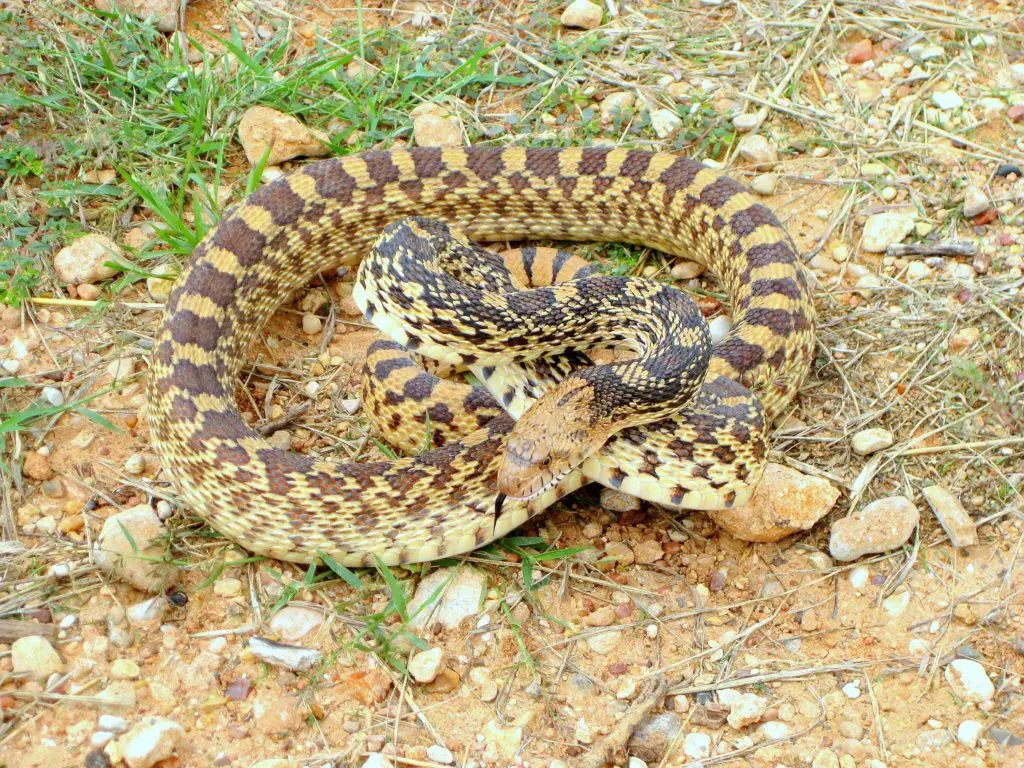Why is it called a Bull Snake? Keep reading to find out about this and other common questions regarding this subspecies of Gopher Snake…
Last updated on February 1st, 2023 at 09:32 am
Bull Snakes get their name from the distinctive defensive sounds that they produce, called hisses and bellows. Whilst bellows are like a deeper, shorter hiss, both sounds are surprisingly loud thanks to the Bull Snake’s specially adapted larynx. The result is intense hissing that reminds people of the sound a bull makes.
The name isn’t the only confusing thing about these snakes…
If you’ve read the paragraph above, you now know why this species has been given it’s unusual name. To find out more about the precise mechanism behind their sound production, I suggest reading the following scientific study: Sound production in Pituophis melanoleucus (Serpentes: Colubridae) with the first description of a vocal cord in snakes.
Obviously, the reason they make their grunting sounds is pretty simple. It makes them sound bigger and scarier than they are, making predators pause for thought.
It’s also easy to imagine how the name “Bull Snake” stuck, given how willing they are to make these sounds if you disturb them in the wild. Unless you’ve heard one in person, however, it’s definitely confusing to hear of a snake named after a farm animal!
Notwithstanding, the name isn’t the only confusing thing about this snake. In fact, the various misconceptions about their behaviour are almost as widespread as the subspecies itself. Do they eat Rattlesnakes? How big do they really get? Are they venomous?
Let’s dive in and clear these points up while we’re here. We’ll also look at how they relate to the Bull Snake’s vocalisations.
Where do Bull Snakes live?
The Bull Snake (Pituophis catenifer sayi), is a subspecies of the widespread Gopher Snake (Pituophis catenifer). What this means is that it differs from other subspecies genetically and by appearance, but not enough for taxonomists to give it the status of full species.
In the future, scientists may divide the Gopher Snake into a handful of species or more, following more in-depth genetic research.
Until then, the Bull Snake is the most eastern subspecies of Gopher Snake, and you can encounter them all the from Indiana in the east to western Montana in the west. They also range further north than many other large snakes, and have vast areas of distribution in southern Alberta and Saskatchewan, Canada.
To the south, the bull Snakes range extends all the way to north-east Mexico. In these areas it often interbreeds with the Sonoran Gopher Snake (P. c. affinis), making it hard to identify.
What you may notice about this distribution area is that it includes almost all of the Great Plains region, and some of Americas richest farmland. It’s easy to imagine just often people have encountered them over the years, and how much this has helped their common name spread amongst communities.

Do Bull Snakes bite?
Bull Snakes do bite, sometimes. In my experience, though, they’re a lot more likely to bluff than bite. They do a whole defensive performance when disturbed, which includes puffing up, mock striking, hissing, rattling their tail, and of course making their famous bull “bellows”. Actually biting is their last resort.
Something I’ve noticed is that when they do strike, they often just tap you with their nose, or miss completely. It really seems like the aim is to scare you away, rather than get into a real scuffle.
This makes a lot of sense, given that their bites don’t hurt much. They’re about as impressive as a scratch from a cat. I can imagine that if they simply used biting as a defence, it would be completely ineffective against predators like coyotes, for example.
Funnily enough, most of these snakes calm down completely in captivity, making Bull Snake husbandry incredibly easy. Nonetheless, their scary reputation still puts a lot of keepers off acquiring one.
Are Bull Snakes venomous?
Bull Snakes are not venomous. They’d just like it if everyone thought they were. As we’ve just discussed, rattling their tail is one of their main defences. This produces a low hum, that is no way near as loud as that of a Rattlesnake, but does sound vaguely similar.
On top of this, the rough hissing sound that Bull Snakes make sounds a lot like a Rattlesnake’s tail, despite being produced in a completely different way.
When you take into consideration the fact that they also have dorsal markings that resemble those of some Rattlesnakes, you can see that Bull Snakes are a pretty good Rattlesnake mimic.
This resemblance through sound and appearance probably does help Bull Snakes dissuade some predators, making it a good defence against other animals.
Sadly, it doesn’t work on humans, who often mistake harmless Bull Snakes for Rattlesnakes and kill them.

Do Bull Snakes eat Rattlesnakes?
Bull Snakes are specialist rodent predators – they have no interest in eating other snakes. So no, they do not eat Rattlesnakes. Surveys of their dietary habits in the wild and numerous anecdotal accounts of their behaviour point to them having a preference for Gophers and Ground Squirrels.
Not surprising really that this subspecies of Gopher Snake likes to eat – Gophers! Occasionally, they have also been known to eat small rabbits, birds and bird’s eggs.
There are snakes that eat other snakes, however. The name for this dietary preference is ophiophagy, and the North American Milk Snakes and Kingsnakes both practice it. They will readily eat Rattlesnakes, Copperheads or Coral Snakes, and are highly immune to their venom.
Bull Snake prey items in order of preference:
- Gophers
- Ground squirrels
- Rats/mice
- Rabbits
- Birds
- Bird’s eggs
- Lizards

The relationship between prey and refugia
Bull Snakes and other Gopher Snakes have a unique relationship with their prey. They don’t just eat gophers, they also use their burrows as refugia. A refugia is a hiding place that offers protection from the environment.
Unlike most Milk Snakes, for example, adult Bull Snakes are too big to hide under a flat rock, so need somewhere with ample space to call home.
Though Bull Snakes are very good at digging, they usually dig to bury their eggs. When they want a nice cool place to from the midday sun, their preference is for rodent burrows.
These refugia are ready-made and often deep enough to stay cool during even the hottest weather. The fact that they are ready-made is convenient because it means the snakes can rest after eating the rodents, without having to dig a burrow or search for a place to hide.

How big do Bull Snakes get?
Part of what makes a Bull Snake bullish is its large size. Imagine a teeny-tiny snake making grunting sounds. It would jsut be cute, not scary. Likewise
Their large mass it what makes their vocalisations intimidating, and even the babies are chunkier than most other North American colubrids.
Adult Bull Snakes regularly get to 4-6ft (1.3-1.8m) in length, and the largest recorded specimen was 8’4’’ (2.56m). This makes them America’s second or third largest snake, after the Eastern Rat Snake (Pantherophis alleghaniensis), which reaches a similar size, and the humongous Eastern Indigo Snake (Drymarchon couperi) which gets to 8’7.5’’ (262.9cm).
| Age | Size |
| Hatchlings | 12-18 inches (30-45cm) |
| average adults | 4-6ft (1.3-1.8m) |
| Exceptional adults | 7ft (2.1m) + |
| Record | 8’4’’ (2.56m) |
The bottom line
Bull snakes got their name from the sound they make. They evolved in the Great Plains ecosystem, where large ungulates like the Buffalo used to roam freely.
In this kind of environment, you need to be heard, or you’ll be stepped on. Whereas Rattlesnakes came up with a rattle to achieve this, Bull Snakes instead rely on an epiglottal keel, and laryngeal septum in their Larynx to produce loud hisses and bellows.
The result is – as you’ve just found out – a snake that sounds (kind of) like a bull.
